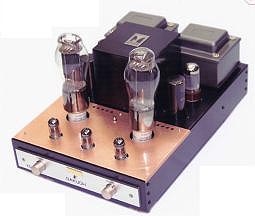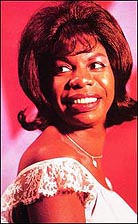 |
|
|
Don't get me wrong. I know there are significant differences. I'm just aware that people responded to the original Edison Shellac recordings in the same way. And I'm also more than a little doubtful about all the claims about how hifi equipment has so dramatically improved over the last few years. But certain outstanding components do things that at least this audiophile has not heard before. What the Living Voices do is 'suspend disbelief'. I don't suppose they are actually more accurate to the signal - it may just be that they create a sound that fools me better. The reality is, it doesn't matter. Close my eyes and my ears can be fooled into thinking I'm at a live session of a three-piece Jazz ensemble. Unusually, the speakers excel at reproducing cymbal signatures convincingly. Guitar too, both electric and acoustic, can produce this 'it's the real thing' effect. Piano though is another matter and we are still a bit of a way off. Voices sound real but amplified and negotiated through a microphone. They don't sound actually there, live, natural, and I don't expect that will ever be possible.
|
|
|
So how is this coming about? I suspect that we are actually getting a more tactile quality within the rendition of tonality and instrumental color which is simply more involving than the norm for high quality transducers. Partly this is a function of speed, impact and delicacy. We are for instance used to the concept of inner detail, which reveals harmonic cues particularly within the body and decay of a note. The 2s appear not just to be reproducing accurate dynamics on a macro scale but a fine-grained version of micro-dynamic nuances that mean you can hear the echo of a dynamic rise as a drum skin is hit, and then something close to the full complexity of its decay. And this not just off the skin but in the air itself. I've had several experienced listeners 'round recently a few of whom are by no means traditional fans of Living Voice speakers. Each one of them was struck by the realism of a drum solo in Patricia Barber's Modern Cool. Ben Webster's Live at the Renaissance produces the same effect (and it's mono!), so much so that a professional musician reacted with a 'it may as well be live'. There are of course only a few recordings that are capable of reaching this level of realism (and I have to admit that so far, I've only been able to produce this effect using vinyl), so what about bread and butter albums? |
|
 |
|
I'm particularly fond of the Yo Ma Bach Unaccompanied Cello Suites LP [CBS D3 37867[ even though it is a digital recording. It turns out Kevin Scott has used the Cello Suites to voice the speaker and this is obvious from the first notes. When reproduced well, the shape of the soundfield emanating from the cello isn't uniform. Instead, like in real life, depending on the amount of harmonics in the note, the cello will breathe in and out, with sounds expanding and contracting in different directions, taking on more palpability at the fret level or even almost behind the instrument. This is what makes it a living, breathing thing and allows the musician to impose his or her own intimate signature on the piece. Very few speakers are capable of reproducing that kind of transparency and air around an instrument. The OBX-R2 is one of the more accomplished.
|
|
|
|
 |
|
What happens when the recording is less than stellar? The response of the OBX-R2 is that it loses the 'actually live' sound and defaults back to a musical reproduction that is extraordinarily rich in tonal color and a pliable, tactile density of timbre. What makes them so special is that they are more attentive to those minute musical cues that are crucial to creating the 'live' sensation than anything else I've had the privilege to hear so far. Of course they don't have the ultimate dynamics of a good set of horns - and that may be a good thing. They don't have that zing-like immediacy of a great electrostatic either but you can drive them with a lively light valve amp rather than the muscle-bound gorillas the 'stats require. They are less neutral or more boxy than some other reference speakers and they don't go as deep. But in terms of cutting away the dross and therefor revealing the true emotional impact of a piece, I've yet to hear something more convincing.
|
|
|
The OBX-R2s are speakers that by their very nature ask to be partnered with the finest sources and amplification available. It comes as no surprise to hear that they were designed primarily using Kondo amplifiers, Kevin Scott being the UK distributor. These speakers will give you a very close reading of the upstream components so it's worth putting work into getting them right. But do so and you will be rewarded as I have, with many hours of sheer pleasure. Plain they may be but the sound is anything but. And while the sound is good, if you want good sound there are quite a lot of choices around. But if you want good music, no, make that great music, the choices narrow drastically and the OBX-R2s are one of the stars.
Take Nina Simone's After Hours, by no means an easy set of works for an audio system to unravel. However the LVs appear with an innate, almost |
|
 |
|
instinctive understanding of the proportions and architecture of a piece of music and not just the architecture but the way that musical structure informs and indeed contributes to creating the emotional significance of the piece. So yes, you do get great transparency, punch and weight. These are natural reference speakers. But they never stray into the sterile, cold, might one say musically dead transducer types that are often used as references.
It would be nice to pretend the OBX-R2s were our own little discovery at 6moons. In reality however, at least in the UK they are very well known. In fact they are probably the most widely used reference by the serious audio press, the staple of Roy Gregory and others at Hifi+, not to mention being an Editor's Choice of most of the other audio magazines. [Hi-Fi+ Product of the Year 2000; Hi-Fi+ Editor's Choice 2000; Hi-Fi Choice Editor's Choice; The Absolute Sound Golden Ear Award 2001 - Ed.] With that kind of backing, it's almost as if they represented the new establishment. If they in fact do, it is with every reason to deserve this position. Did I for instance mention that they measure up at 94dB? That means a whole world of limited-power |
|
|
|
 |
|
|
amplification comes into play though personally, I feel they are happiest with at least 20 good watts to bring out the stunning dynamics they are capable of.
So are there any faults? Well, they are not full-range speakers. For me, it's not as if I ever missed the deep bass notes. But there is no pretending - they don't operate across the last half octave. If it's deep bass you crave, you'll need a very fast and agile set of subwoofers. Something like the Kinergetics comes to mind. Personally, I never felt I needed it, preferring the sound as delivered to the subs I had on hand. Instead of concentrating on shaking the building with bass, these speakers manage to render not just the finest and largest soundstage I've ever heard but their associated imaging will also redefine what most people think is possible in audio reproduction. That is, we aren't talking about that needlepoint imaging some stand mounts deliver. Have you ever heard that kind of imaging in real life?
No, it's not sharp but it's not diffuse either. It is just absolutely right: The sound waves emanate from a place in space just like they do in real life. When that place moves, you follow. Imaging may not be a crucial quality to audiophile pleasure but it is essential to creating that truly believable experience. Combine this imaging magic with a really dense and powerful projection of the energy inside the note as it is born spreading lightning-fast and you have a combination of features I have not come across before in any speaker or enjoyed as much. Electrostatics and all the large speakers I've heard thus far (from Kharmas to the larger horns) simply don't enter the same class. And note this is being done with a sharp-cornered cabinet, tweeters offset. Superb in revealing layers of inner detail, with an attentiveness and precision which is only at the service of the musical experience, these speakers should properly be understood as a landmark in the British speaker-making story and quite simply, one of the most accomplished speakers available today.
There are quite a number of speakers that can reproduce sounds with great accuracy to the source. But there are very few that can play music with the emotion, power, meaning and visceral impact that produces a transformative effect. In the end, I believe these are speakers which, when well matched with good audio components upstream, will as they did for me not only change what you listen to and how, they will, in all probability, change your relationship to music itself.
|
|
|
|
|
 |
|
 |
|
|
 |
|
|
 |
|
|
|
|
 |
|
|
|
|
|
|
|
|
|
|
|
|
|
|
|
|